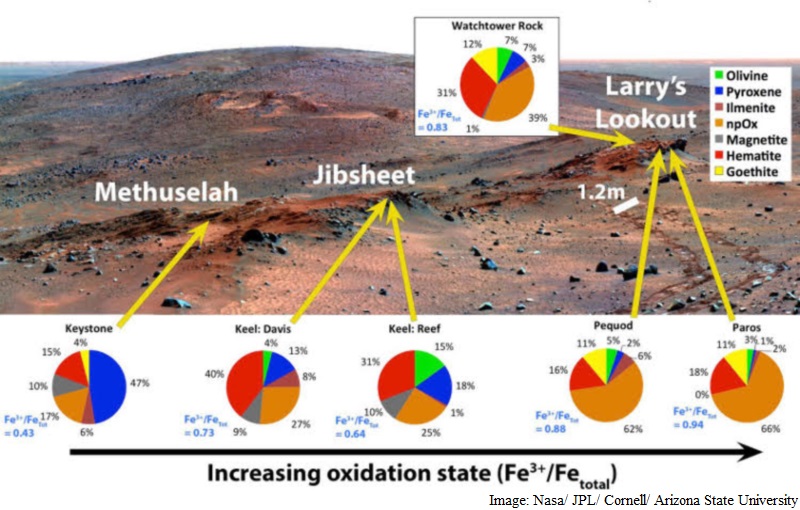- Home
- Science
- Science News
- Mars Shows Signs of Acid Fog: Study
Mars Shows Signs of Acid Fog: Study

Shoshanna Cole from the Cornell University used data gathered by multiple instruments on the 2003 Mars Exploration Rover Spirit to tease out information from exposures of the ancient bedrock.
The work focused on the 'Watchtower Class' outcrops on Cumberland Ridge and the Husband Hill summit.
By combining data from previous studies of the area on Mars, Cole saw some intriguing patterns emerge.
Spirit examined "Watchtower Class" rocks at a dozen locations spanning about 200 meters along Cumberland Ridge and the Husband Hill summit.
Across Cumberland Ridge the data showed there was a surprisingly wide range in the proportion of oxidized iron to total iron, as if something had reacted with the iron in these rocks to different degrees.
Meanwhile, further data showed that the minerals within the rocks changed and lost their structure, becoming less crystalline and more amorphous.
These trends match the size of small bumps, which Cole calls agglomerations, seen in Pancam and Microscopic Imager pictures of the rocks.
"So we can see the agglomerations progress in size from west to east and the iron changes in the same way," Cole said. "It was super cool."
But the fact that the rocks were otherwise the same in composition indicates that they were originally identical.
"That makes us think that they were made of the same stuff when they started out. Then something happened to make them different from each other," she noted.
Cole hypothesises that the rocks were exposed to acidic water vapour from volcanic eruptions, similar to the corrosive volcanic smog that poses health hazards in Hawaii from the eruptions of Kilauea.
When the Martian smog landed on the surface of the rocks it dissolved some minerals, forming a gel.
Then the water evaporated, leaving behind a cementing agent that resulted in the agglomerations.
She presented the findings at the annual meeting of the Geological Society of America in Baltimore, Maryland, on November 2.
Get your daily dose of tech news, reviews, and insights, in under 80 characters on Gadgets 360 Turbo. Connect with fellow tech lovers on our Forum. Follow us on X, Facebook, WhatsApp, Threads and Google News for instant updates. Catch all the action on our YouTube channel.
Related Stories
- Samsung Galaxy Unpacked 2025
- ChatGPT
- Redmi Note 14 Pro+
- iPhone 16
- Apple Vision Pro
- Oneplus 12
- OnePlus Nord CE 3 Lite 5G
- iPhone 13
- Xiaomi 14 Pro
- Oppo Find N3
- Tecno Spark Go (2023)
- Realme V30
- Best Phones Under 25000
- Samsung Galaxy S24 Series
- Cryptocurrency
- iQoo 12
- Samsung Galaxy S24 Ultra
- Giottus
- Samsung Galaxy Z Flip 5
- Apple 'Scary Fast'
- Housefull 5
- GoPro Hero 12 Black Review
- Invincible Season 2
- JioGlass
- HD Ready TV
- Laptop Under 50000
- Smartwatch Under 10000
- Latest Mobile Phones
- Compare Phones
- Honor Win RT
- Honor Win
- Xiaomi 17 Ultra Leica Edition
- Xiaomi 17 Ultra
- Huawei Nova 15
- Huawei Nova 15 Pro
- Huawei Nova 15 Ultra
- OnePlus 15R
- Asus ProArt P16
- MacBook Pro 14-inch (M5, 2025)
- OPPO Pad Air 5
- Huawei MatePad 11.5 (2026)
- Xiaomi Watch 5
- Huawei Watch 10th Anniversary Edition
- Acerpure Nitro Z Series 100-inch QLED TV
- Samsung 43 Inch LED Ultra HD (4K) Smart TV (UA43UE81AFULXL)
- Asus ROG Ally
- Nintendo Switch Lite
- Haier 1.6 Ton 5 Star Inverter Split AC (HSU19G-MZAID5BN-INV)
- Haier 1.6 Ton 5 Star Inverter Split AC (HSU19G-MZAIM5BN-INV)

















